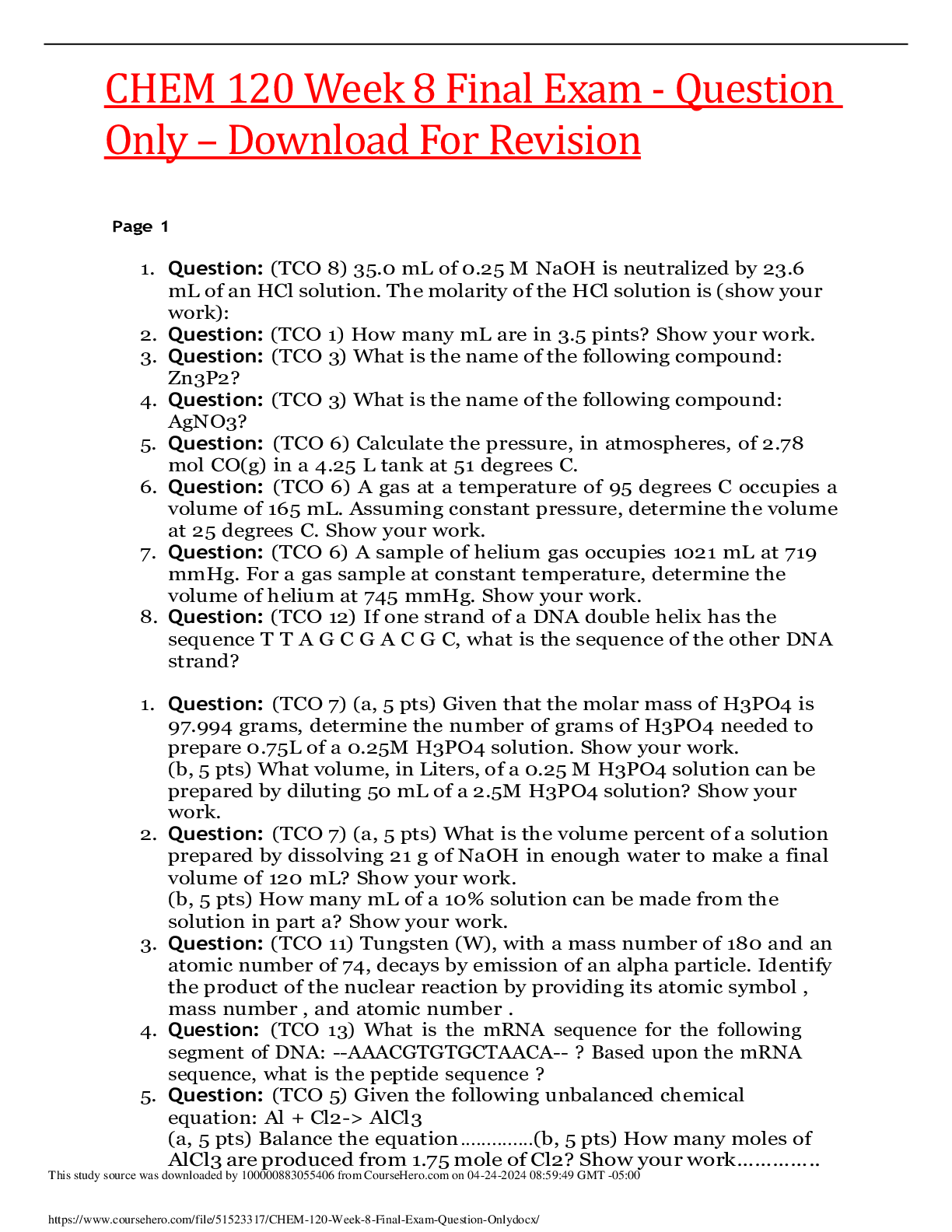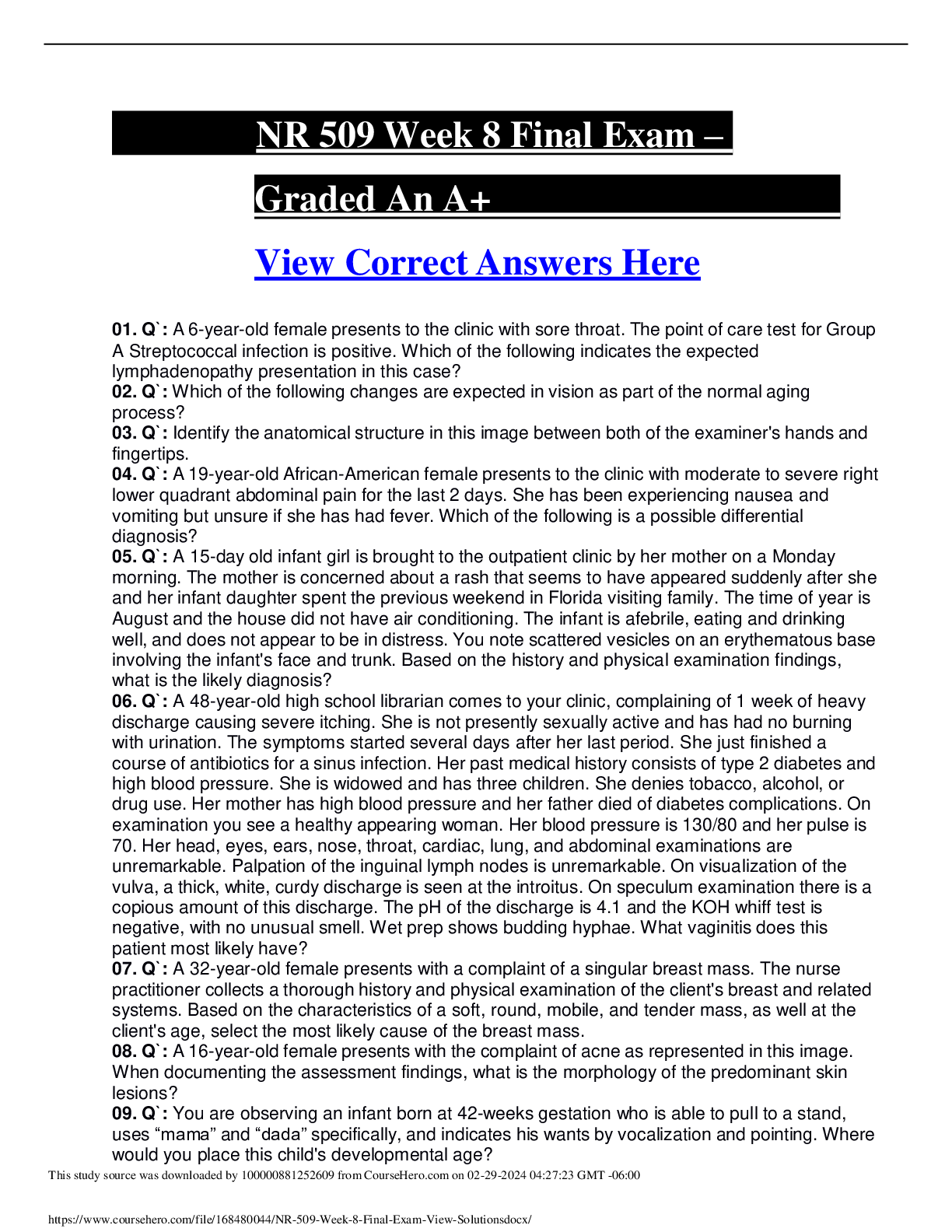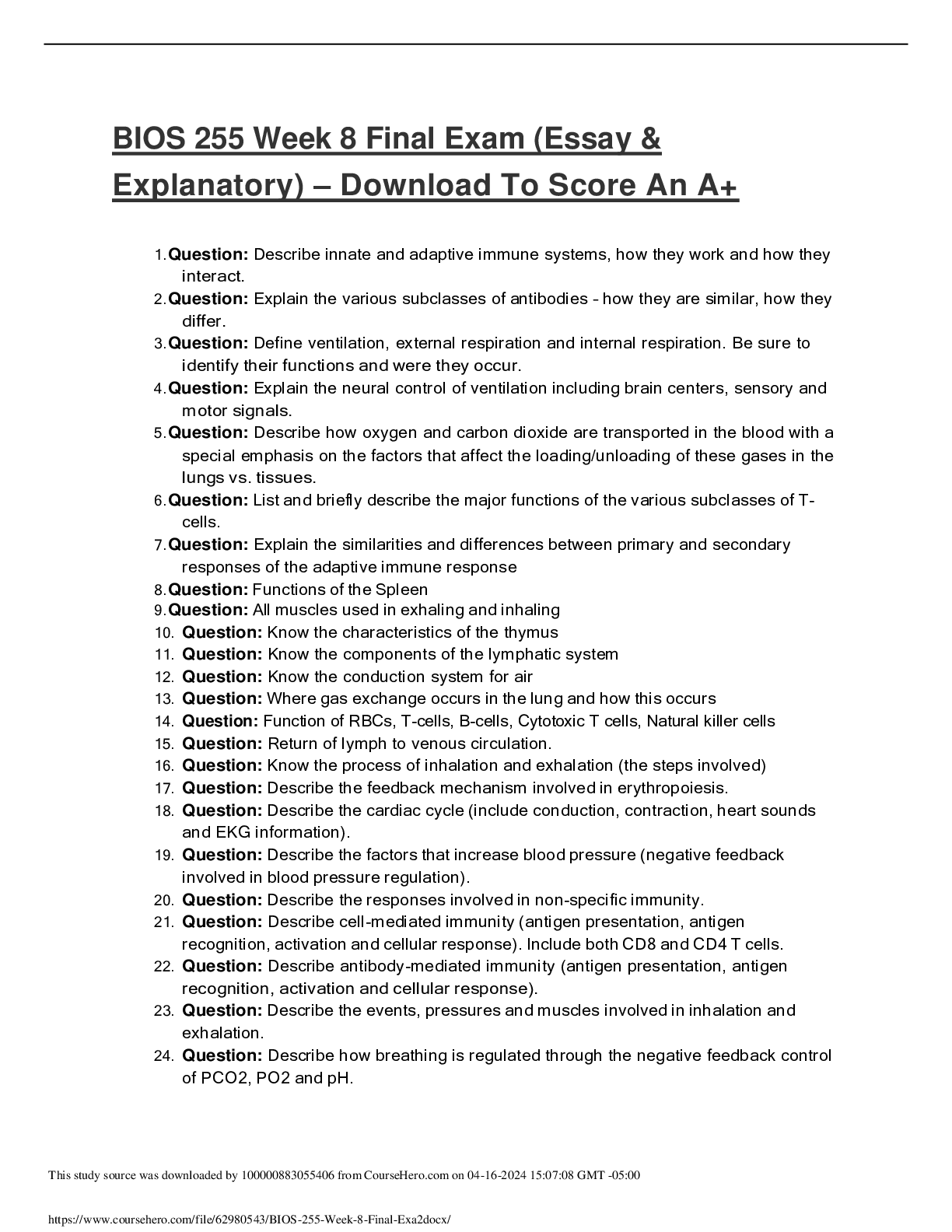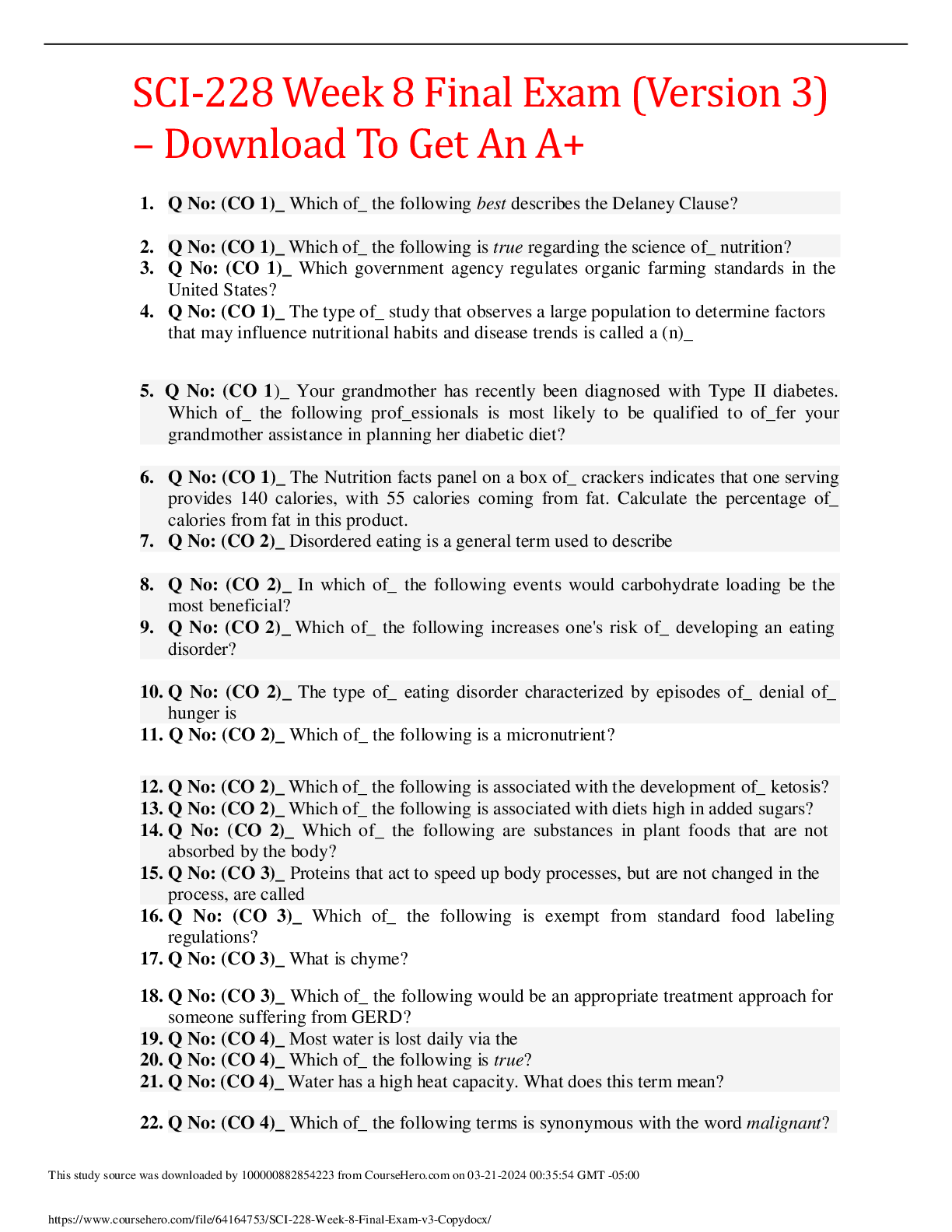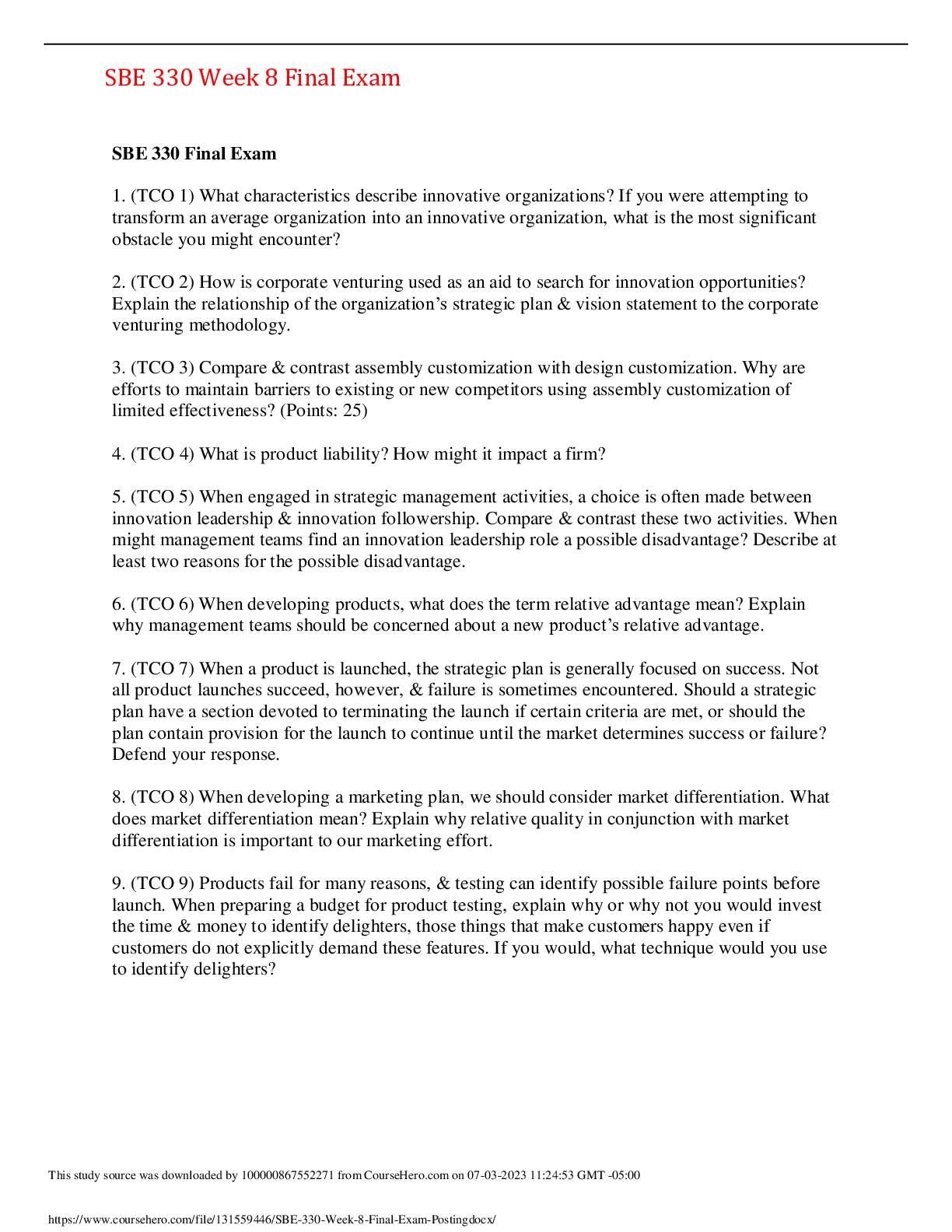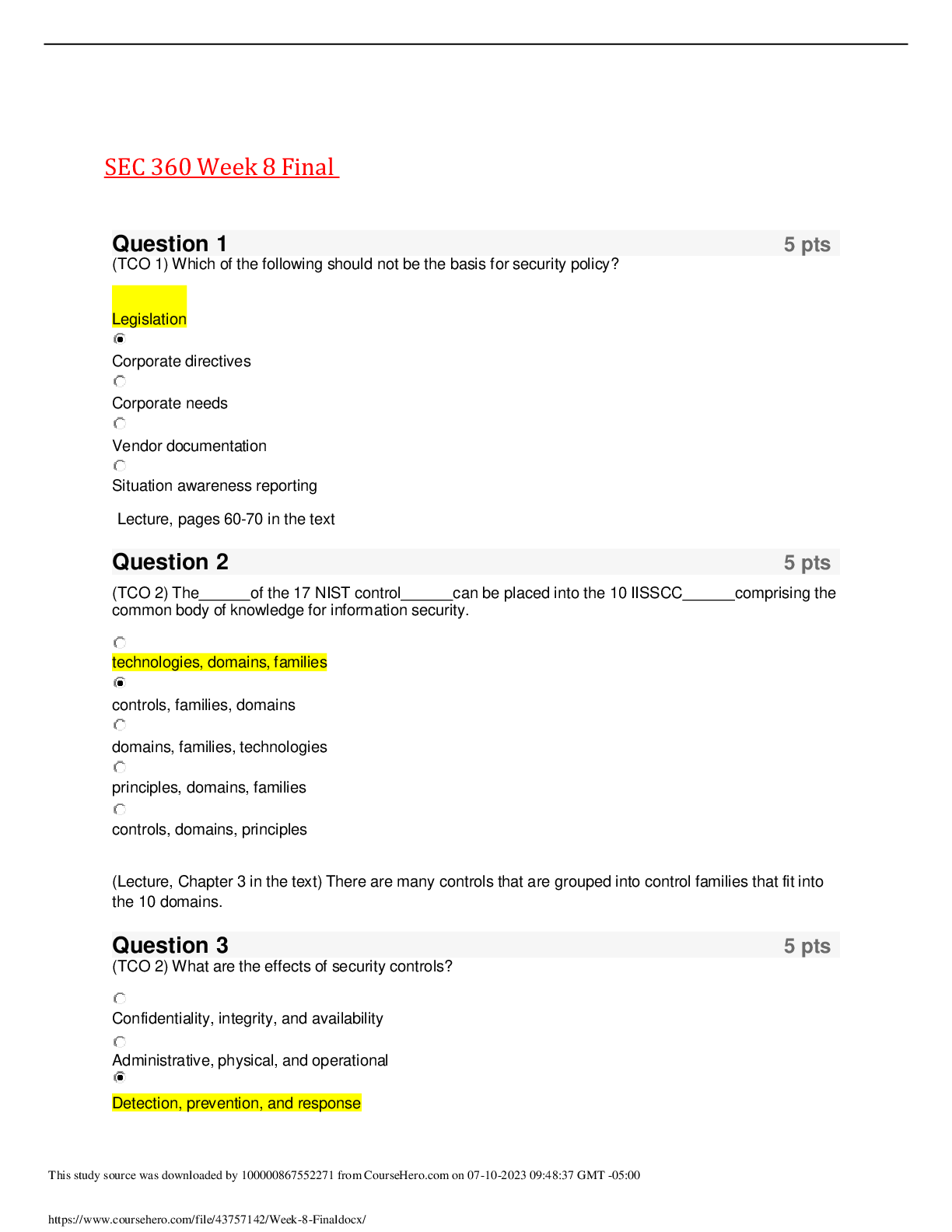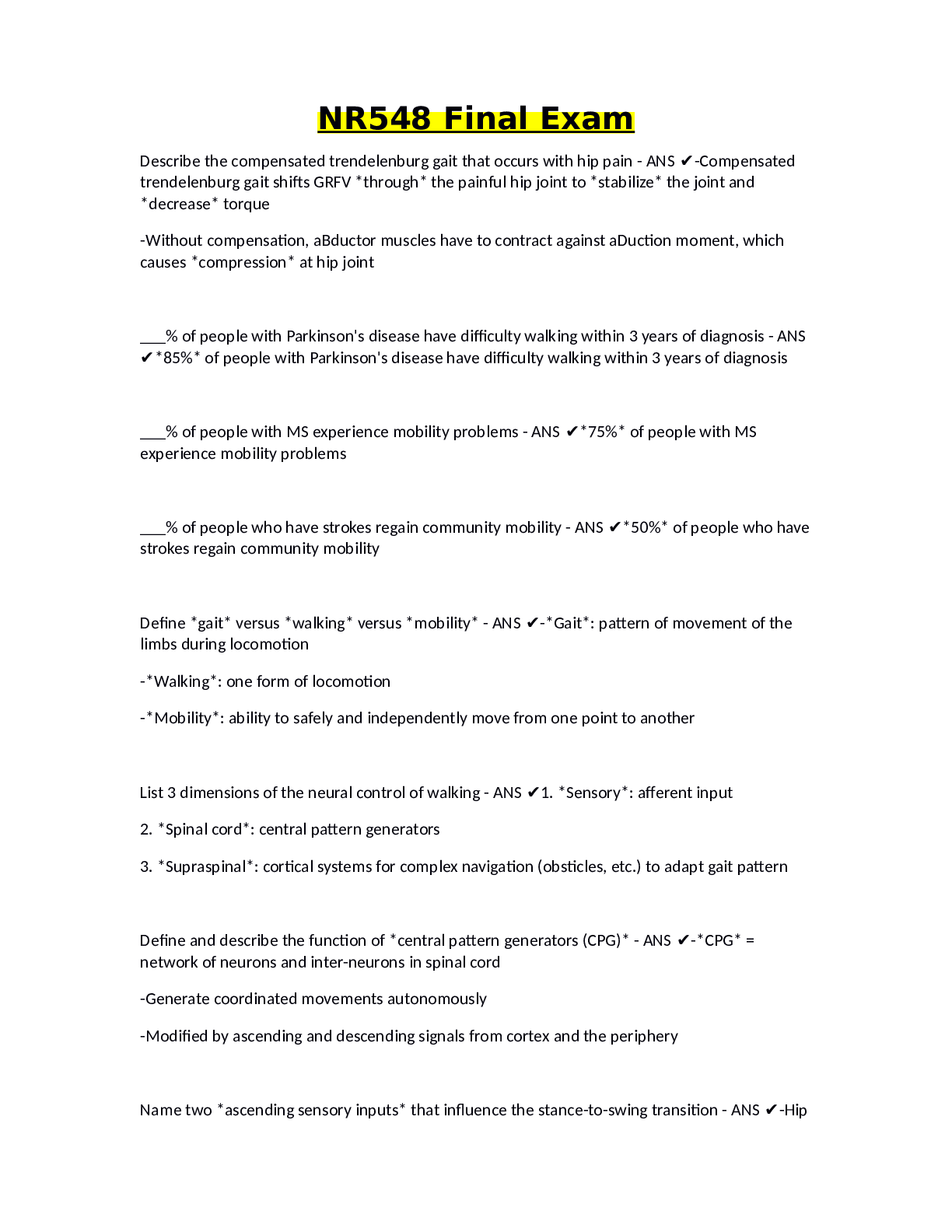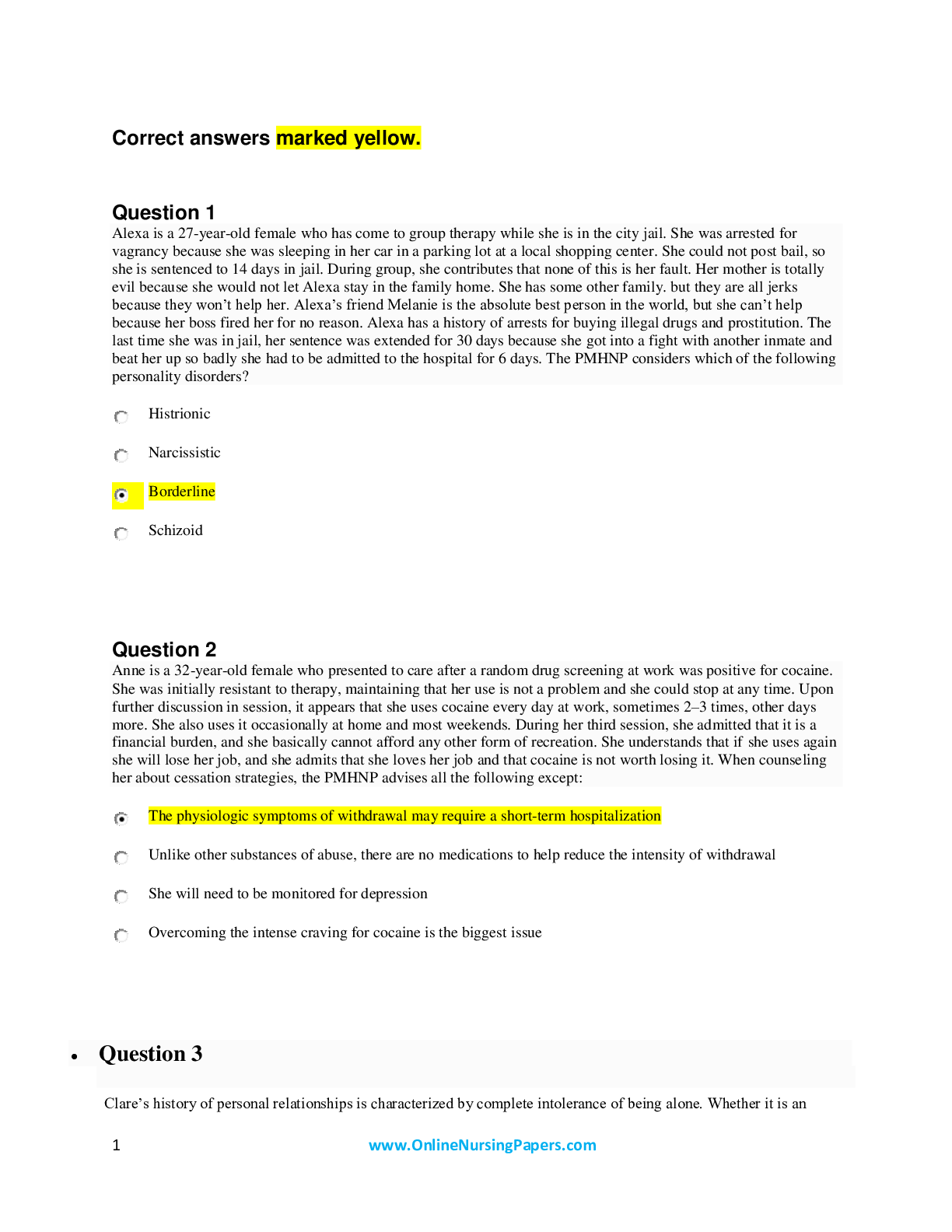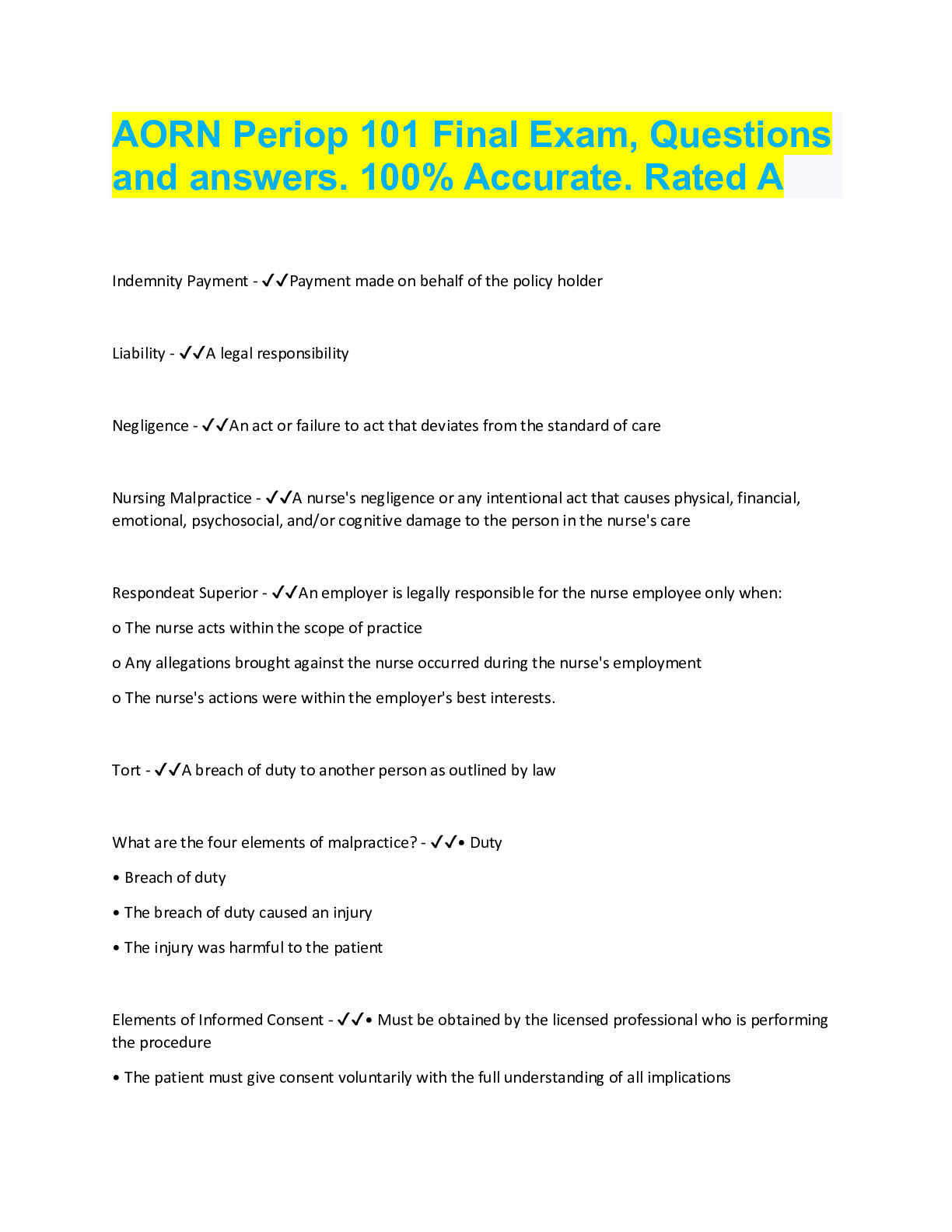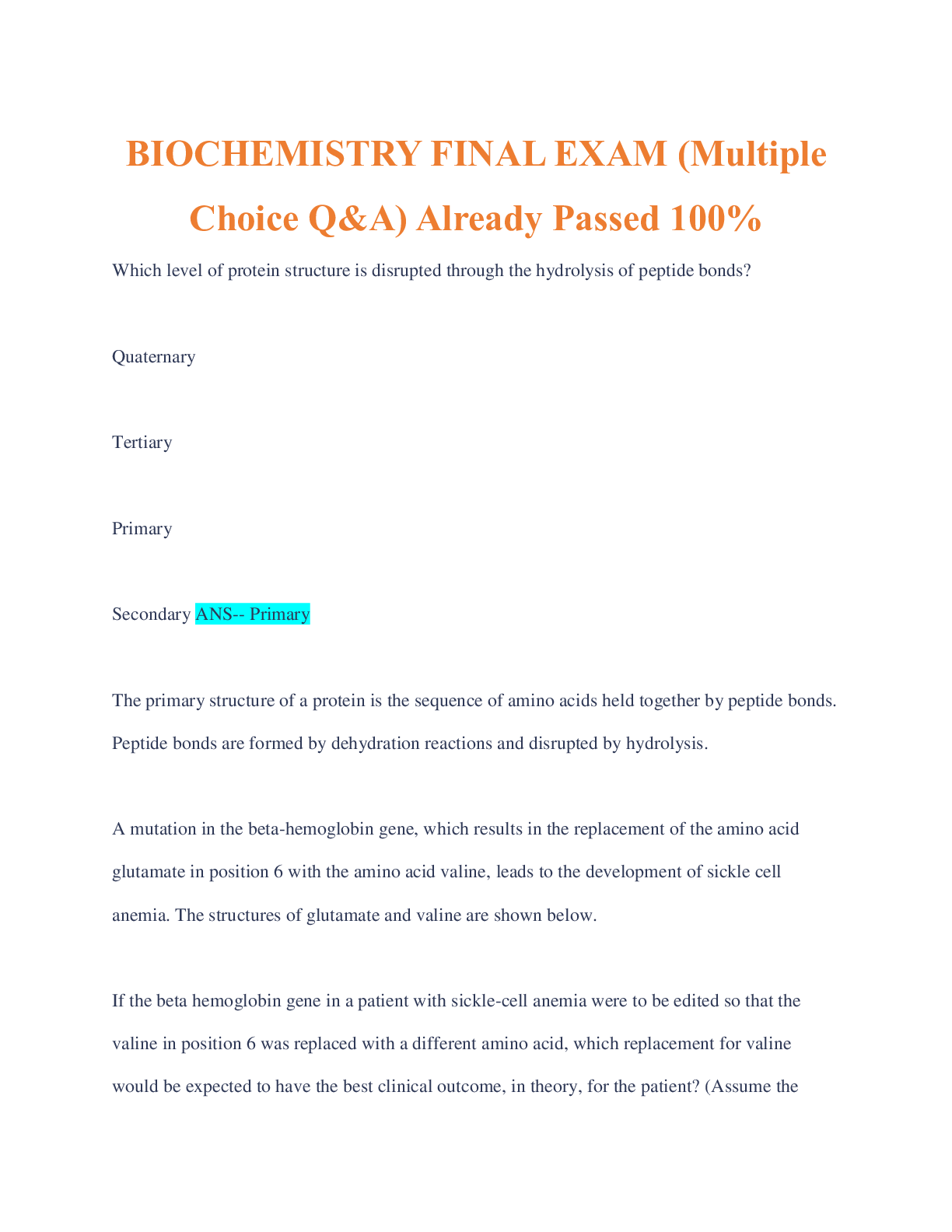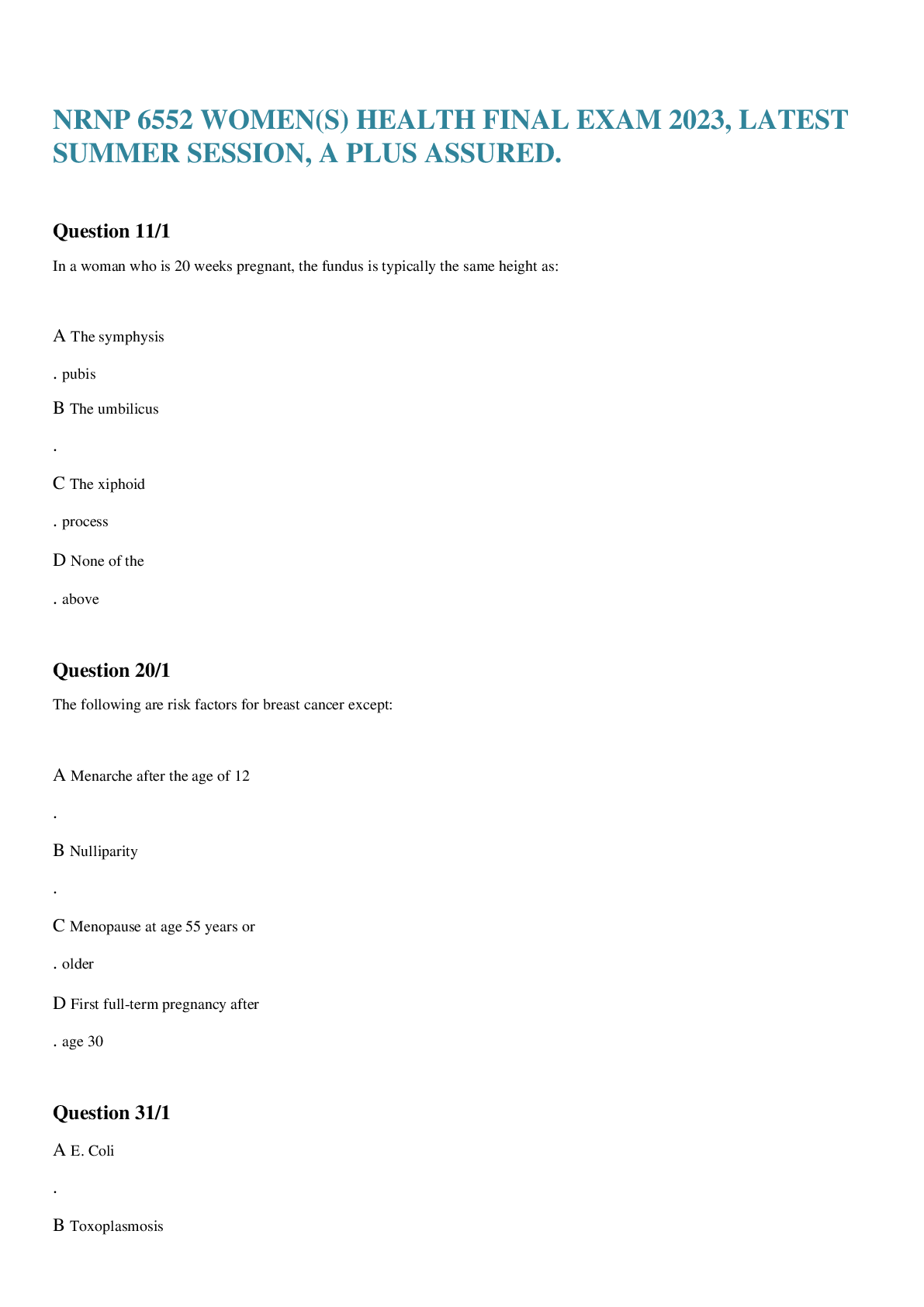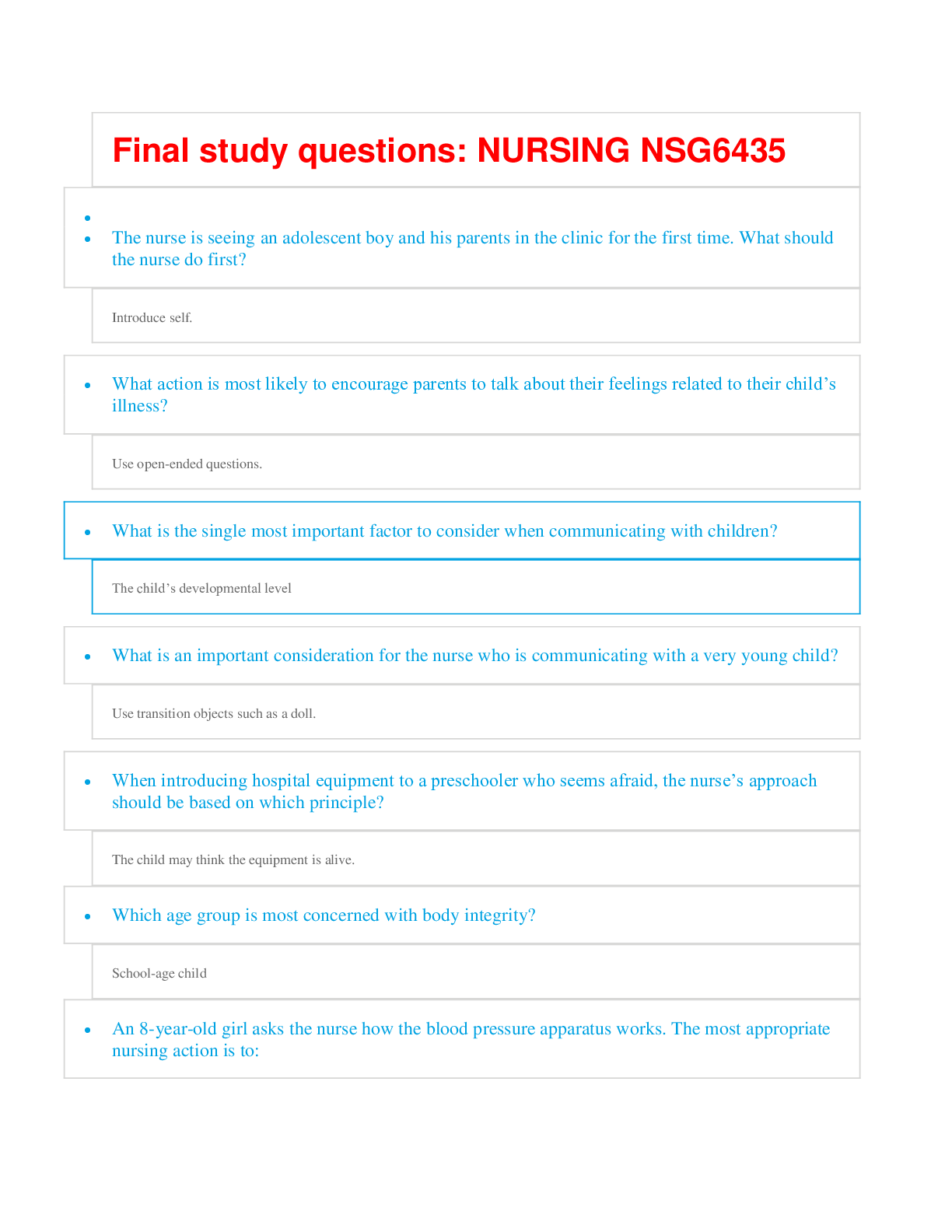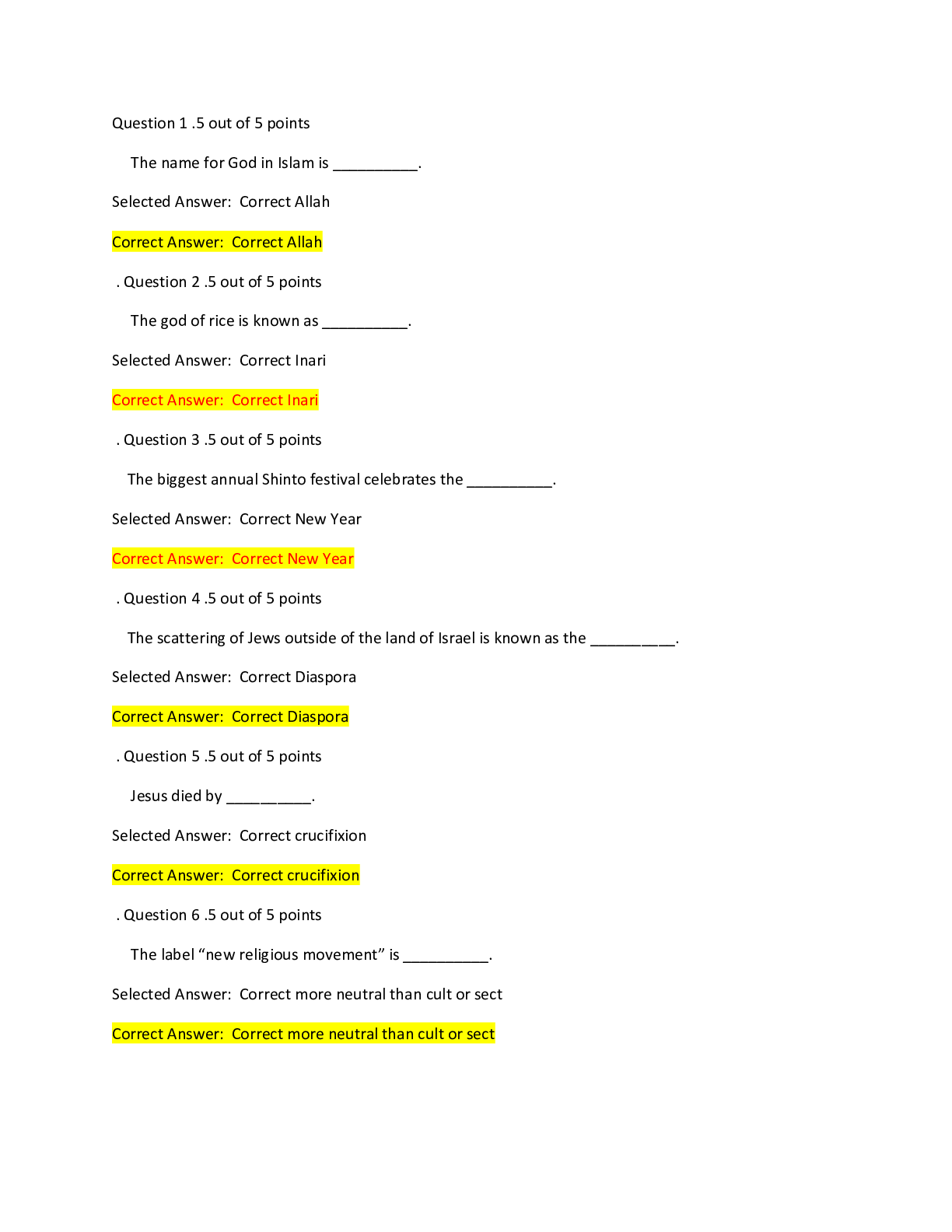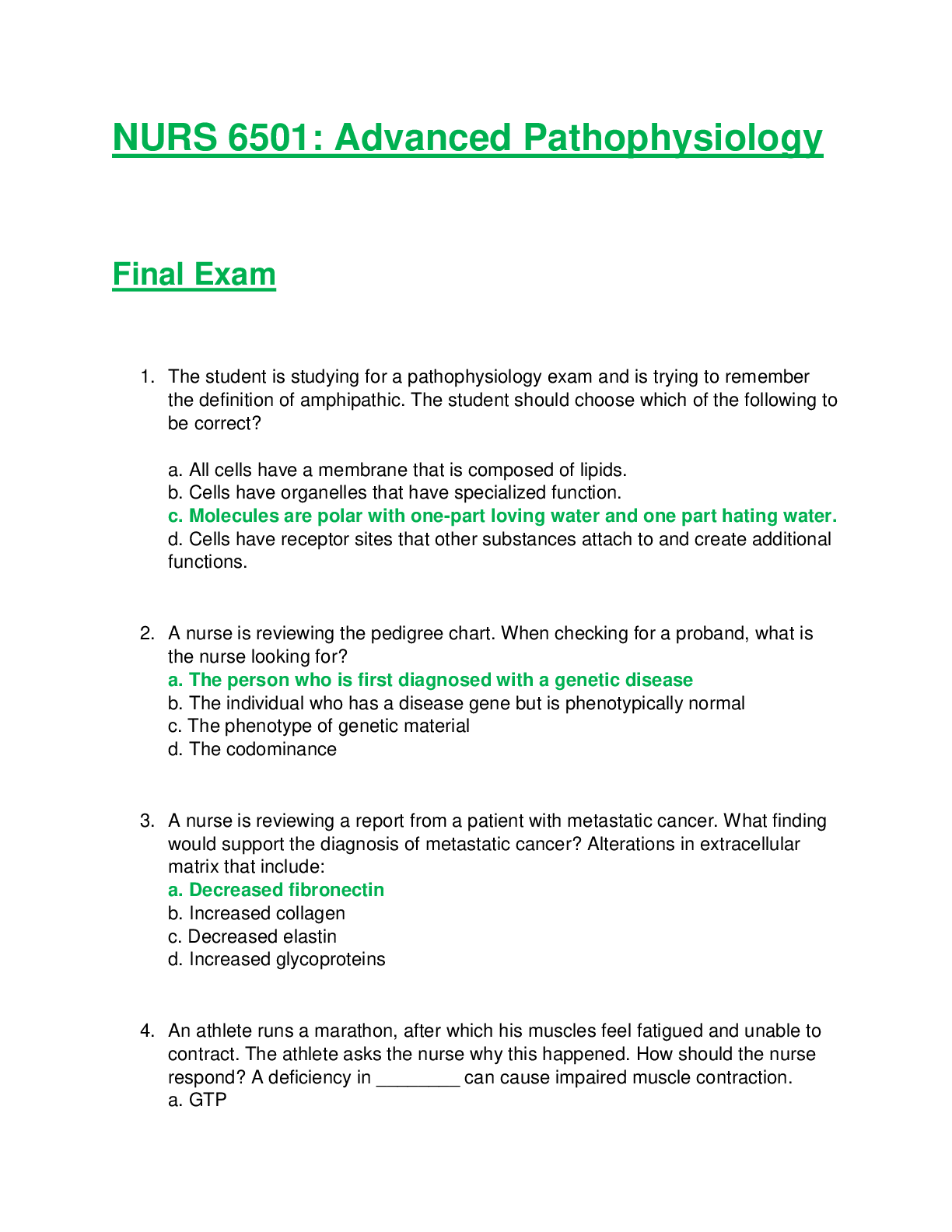Accounting > FINAL EXAM > SCI-228 Week 8 Final Exam (Version 1) -100% Correct Answers, Graded An A+ (All)
SCI-228 Week 8 Final Exam (Version 1) -100% Correct Answers, Graded An A+
Document Content and Description Below
Page: 1 2 3 Question 1.Question : (TCO 10) Growth acceleration in adolescence is primarily driven by: Student Answer: increased physical activity. increased caloric intake. hormon... al changes. both increased physical activity and increased caloric intake. Points Received: 2 of 2 Comments: Question 2.Question : (TCO 10) On average, Americans have a life expectancy that reaches into the: Student Answer: early 70s. late 70s. early 80s. late 80s. Points Received: 2 of 2 Comments: Question 3.Question : (TCO 10) The brain grows the most rapidly during the first years of life. Student Answer: two five eight 10 Points Received: 2 of 2 Comments: Question 4.Question : (TCO 9) The absorption of Vitamin increases in older adults. Student Answer: A B12 C D Points Received: 2 of 2 Comments: Question 5.Question : (TCO 9) Which of the following increases one's risk of developing an eating disorder? Student Answer: Large family size Holding the first order of birth Having a sibling with an eating disorder All of these Points Received: 2 of 2 Comments: Question 6.Question : (TCO 9) Impulsive, low self-esteem, seeks attention, extroverted, and erratic describe personality traits of: Student Answer: anorexia nervosa. bulimia nervosa. binge eating disorder. obesity. Points Received: 2 of 2 Comments: Question 7.Question : (TCO 7) Who is at risk for a Vitamin E deficiency? Student Answer: Premature infants Postmenopausal women Male athletes The elderly Points Received: 2 of 2 Comments: Question 8.Question : (TCO 7) Which water-soluble vitamin can regenerate Vitamin E after it has been oxidized? Student Answer: Vitamin D Vitamin B12 Vitamin C Folate Points Received: 2 of 2 Comments: Question 9.Question : (TCO 7) How do antioxidant vitamins stabilize free radicals? Student Answer: Donate electrons or hydrogens Enzymatic destruction Phagocytosis Break down and convert them to less damaging molecules Points Received: 2 of 2 Comments: Question 10 Question : . (TCO 8) Which of the following statements is FALSE regarding the mineral, selenium? Student Answer: Selenium is needed in minute amounts by the human body. Selenium is involved in the maintenance of basal metabolism and body temperature. Selenium is only present in foods of animal origin. Selenium is a component of the antioxidant glutathione peroxidase enzyme system. Points Received: 2 of 2 Comments: Question 11.Question : (TCO 8) Where does the body store selenium? Student Answer: In the liver In adipose tissue In the lymph system In body proteins Points Received: 2 of 2 Comments: Question 12 Question : . (TCO 8) Which research study demonstrated a link between Vitamin E consumption and a decreased risk of heart disease in smokers? Student Answer: ADA Study HOPE Study NIH Study ATBC Study Points Received: 2 of 2 Comments: Question 13 Question : . (TCO 8) Which of the following hormones requires selenium for its synthesis? Student Answer: Estrogen Insulin Cortisol Thyroxine Points Received: 2 of 2 Comments: Question 14 Question : . (TCO 8) Research studies have consistently demonstrated an association between a reduced risk of cancer and: Student Answer: the use of Vitamin C supplements. increased consumption of fruits and vegetables. increased consumption of monounsaturated fatty acids. the use of beta-carotene supplements. Points Received: 2 of 2 Comments: Question 15 Question : . (TCO 7,8) Fluorosis is associated with: Student Answer: insufficient intake of fluoride. consuming too much fluoride. Alzheimer's disease. osteoporosis. Points Received: 2 of 2 Comments: Question 16 Question : . (TCOs 7, 8) Mary G. is 60 years old and at risk for osteoporosis. Which of the following dietary supplements would be the MOST helpful to minimize bone loss? Student Answer: Magnesium and fluoride Vitamin K and fluoride Calcium and phosphorus Calcium and Vitamin D Points Received: 2 of 2 Comments: Question 17 Question : . (TCO 7) of an adult's healthy body weight is fluid. Student Answer: Ten to 30% Thirty to 50% Fifty to 70% Seventy to 90% Points Received: 2 of 2 Comments: Page: 1 2 3 Page: 1 2 3 Question 1.Question : (TCO 8) Which of the following do sodium and potassium NOT have in common? Student Answer: Rich sources of both include fresh foods, such as bananas, cantaloupe, and potatoes. Both participate in maintaining fluid balance. Both are involved in nerve transmission. Both are major electrolytes in the body. Points Received: 2 of 2 Comments: Question 2.Question : (TCO 8) Water has a high heat capacity. What does this term mean? Student Answer: Water is resistant to changes in temperature. Water heats up or cools down very quickly. Water provides a useful source of stored kilocalories. Water transports the energy-yielding nutrients throughout the body. Points Received: 2 of 2 Comments: Question 3.Question : (TCO 8) Which of the following is TRUE? Student Answer: Water freely moves across cell membranes. Water and electrolytes move across the cell membranes only through protein channels. Electrolytes freely move across cell membranes. Water and electrolytes cannot move across cell membranes. Points Received: 2 of 2 Comments: Question 4.Question : (TCO 8) All of the following are major functions of sodium EXCEPT: Student Answer: assists in muscle contraction. maintains fluid balance. maintains normal heart rhythm. maintains acid-base balance. Points Received: 0 of 2 Comments: Potassium helps with heart rhythm. Sodium is a big part of fluid balance so C is the correct answer. Question 5.Question : (TCO 8) The majority of our body's phosphorus is stored in the: Student Answer: kidneys. bones. blood. liver. Points Received: 2 of 2 Comments: Question 6.Question : (TCO 8) Which of the following will likely result if the concentration of electrolytes inside a cell is higher than in the extracellular environment? Student Answer: The cell will burst. The cell will shrink and dry up. The cell will undergo mitosis and divide. The cell will be unaffected. Points Received: 2 of 2 Comments: Question 7.Question : (TCO 5) The vast majority of fat digestion and absorption occurs in the: Student Answer: stomach. liver. small intestine. large intestine. Points Received: 2 of 2 Comments: Question 8.Question : (TCO 5) Which of the following statements is TRUE about trans fatty acids? Student Answer: They are made by the body in large quantities. Their amounts are currently required on food labels. They decrease the risk of developing heart disease. They result from the hydrogenation process. Points Received: 2 of 2 Comments: Question 9.Question : (TCO 5) Which of the following ingredients would alert you to the presence of trans-fatty acids in a product? Student Answer: Hydrogenated vegetable oil Lecithin Liquid corn oil Vitamin E Points Received: 2 of 2 Comments: Question 10 Question : . (TCO 6) Which of the following supplements would you recommend that a vegan add to his or her diet? Student Answer: Protein Fiber Vitamin B12 Vitamin C Points Received: 2 of 2 Comments: Question 11.Question : (TCO 6) Which of the following is associated with marasmus? Student Answer: Distended abdomen Skin and bones appearance Enlarged, fatty liver All of these Points Received: 2 of 2 Comments: Question 12 Question : . (TCO 6) The type of protein-energy malnutrition characterized by a general lack of protein, energy, and nutrients in the diet is called: Student Answer: marasmus. sickle cell anemia. cystic fibrosis. kwashiorkor. Points Received: 2 of 2 Comments: Question 13 Question : . (TCO 4) Which of the following hormones is released when your blood glucose levels fall too low? Student Answer: Insulin Estrogen Bile Glucagon Points Received: 2 of 2 Comments: Question 14 Question : . (TCO 4) is a highly branched arrangement of glucose molecules found in liver and skeletal muscle cells. Student Answer: Fructose Starch Glycogen Raffinose Points Received: 2 of 2 Comments: Question 15 Question : . (TCO 4) Major fructose sources include: Student Answer: milk and cheese. nuts and honey. fruits and vegetables. breads and cereals. Points Received: 2 of 2 Comments: Question 16 Question : . (TCO 1) Which government agency regulates the labeling, sale, distribution, use, and disposal of all pesticides in the United States? Student Answer: Food and Drug Administration United States Department of Agriculture Environmental Protection Agency Centers for Disease Control Points Received: 2 of 2 Comments: Question 17 Question : . (TCO 1) The food-borne illness caused by Campylobacter jejuni is associated with consuming: Student Answer: grains that have been stored in a moist environment. water that has been contaminated with fecal material. tapeworms. contaminated beef or pork. Points Received: 2 of 2 Comments: Question 18 Question : . (TCO 1) Which of the following is associated with the development of ketosis? Student Answer: A diet that contains too much fat A diet that contains insufficient fat A diet that contains too many carbohydrates A diet that contains insufficient carbohydrates Points Received: 2 of 2 Comments: Page: 1 2 3 Question 1.Question : (TCOs 5,10) Jack has a strong family history of heart disease. What lifestyle factors are important for Jack to be aware of to decrease his cardiovascular disease risk? Student Answer: Jack should follow these factors: a.no smoking b.Lower cholesterol c.Maintain a healthy weight d. regular exercise e.Ask a health professional about herbs and nutritional supplements that may be useful in preventing and treating cardiovascular disease f.Consume little or no alcohol g. Eat less saturated fat, more produce & more fiber. h. Arm himself with risk-reducing vitamins i.Give himself some new stress-management tools j. Avoid trans fats. He should also estimate his risk of developing cardiovascular disease by using figure 5.15 of textbook. and ask professional's help. Instructor Explanation: In The Adults, Centers of Disease Control & Prevention, and the Expert Panel on Detestion, Evaluation, and Treatment of High Blood Cholesterol, and the National Institute of Health, it is recommended that the following lifestyle changes to reduce the risk of cardiovascular disease are taken: 1. Maintain total fat intake to within 20%-35% of energy, and keep intake of saturated and trans fats low. Polyunsaturated fats can comprise 10% of total energy intake (e.g. soy and canola oil), while monounsaturated fats like olive oil can comprise 20% of total energy. Some people may have to maintain a lower fat intake to remain healthy. 2. Decrease dietary saturated fat to < 7% of total energy intake. Decrease cholesterol intake to <300 mg per day, and keep trans fatty acids low. Lowering these intakes will lower LDL (Low Density) cholesterol. Replace saturated fat like butter, margarine, and vegetable shortening with healthful oils like olive or canola. 3. Increase dietary intake of whole grains, fruits, and vegetables so that total dietary fiber is 20-30 grams per day, with 10-25 grams coming from fiber sources such as oat bran, beans, and fruits. Foods high in fiber decrease LDL cholesterol levels. 4. Maintain blood glocose levels within normal ranges. Consume foods whole (such as whole-wheat breads and cereals, whole fruits, and vegetables, beans, and legumes). Select low-saturated-fat meats and dairy products, while limiting intake of high-sugar, and high-fat foods (cookies, high-sugar drinks, snacks, candy, fried foods, and conventional fast foods). 5. Eat throughout the day (smaller meals and snacks) instead of eating most calories at night or before bed. 6. Maintain an active lifestyle. Exercise on most days of the week for 30-60 minutes if possible. Exercise will increase HDL (high-density) cholesterol while lowering blood triglycerides. Exercise helps to maintain a healthy body weight, lowers blood pressure, and reduces the risk for diabetes. 7. Maintain a healthy body weight. Points Received: 20 of 20 Comments: Great! Question 2.Question : (TCO 2) Discuss two limitations of the current My Pyramid food guide. Provide possible modifications to the pyramid that would address each of these drawbacks. Student Answer: Two limitations of the current My Pyramid food guide are: a.the serving sizes are relatively small and do not always coincide with the standard amounts of food we eat. These serving sizes are thought unrealistic b.low-fat and low- calorie food choices are not clearly defined in each food category Healthy Eating Pyramid is the response to these limitations. This new type of pyramid addresses the past drawbacks with: a.Substitute precise portions of food (oz., cups) with servings or times daily (i.e. 1-2 times daily, 0-2 servings daily) b. highlighting healthful food choices and emphasizing daily exercise and weight control Instructor Explanation: ANSWERS MAY VARY. The serving sizes, as defined in the Food Guide Pyramid, are relatively small and don't always coincide with the standard amounts of food that we buy, prepare, and serve. Some nutrition professionals believe that these serving sizes are unrealistic, and it's been suggested that the serving sizes should be redefined to more closely match the amount of food that people typically eat. For instance, the serving size of a medium muffin in the Food Guide Pyramid is 1.5 ounces, but many of the muffins sold today range in size from two to eight ounces, meaning that many people eat two to four servings, as defined by the Food Guide Pyramid, even though they're eating only one muffin. It might be more realistic to define a serving size for a muffin as one-quarter or one-half of a medium muffin, as this would more closely match the size of muffins that people choose, and still meet the recommended weight of a muffin as defined by the Food Guide Pyramid. This type of alteration could reduce confusion for consumers. Another drawback is that low- fat and low-calorie food choices aren't clearly defined in each category. Example: two to three servings of meat, poultry, fish, dry beans, eggs, and nuts are suggested in the Pyramid, but these foods differ significantly in their fat content and in the type of fat that they contain. Fish is well recognized for being low in fat and containing a healthier type of fat than what is found in red meats. However, these two types of meat are treated equally in the Pyramid. This also holds true for the bread, cereal, rice, and pasta group. Whole grains are preferable choices, and breads, cereals, and pastas made with refined flour aren't comparable in nutritional value to whole-grain foods. An attempt is made in the Pyramid to draw attention to the fact that fats and sugar are found in all food groups by sprinkling symbols for fat and sugar throughout these groups. However, the symbolism is not really helpful, as it doesn't clearly delineate high-fat and high-sugar foods from those lower in fat and sugar. Points Received: 20 of 20 Comments: Great! Question 3.Question : (TCO 8) Liz has recently been diagnosed with hypertension. Detail the lifestyle changes that are important for Liz to identify and modify in an effort to improve her situation. Student Answer: Liz has to do the following: a.Increase physical activity. Light-intensity exercise (30-60 minutes) can reduce blood pressure, as can more intense exercise lasting 20 to 30 minutes b.Reduce sodium intake c.Reduce alcohol intake. Alcohol consumption can cause high blood pressure. She shouldn't have more than one drink daily d.Lose weight e.Eat more whole grains, fruits, vegetables, and low-fat protein sources Instructor Explanation: There are four steps that Liz could take to minimize the risk of hypertension. 1. She could reduce the amount of sodium in her diet. 2. She could also increase the amount of calcium, magnesium, and potassium in her diet. 3. If she does not get the required amount of fruits and vegatebles in her diet, including the required servings into her diet that may help. 4. There are also medications that can be prescribed to lower a person's blood pressure into the normal range. Points Received: 20 of 20 Comments: Well done! Question 4.Question : (TCO 9) Describe the process by which the body converts sunlight to active Vitamin D in the body. Discuss the hormones and organs involved in this process. Student Answer: Vitamin D doesn't have to come from food, as our body can synthesize it. Our body synthesizes vitamin D by converting a cholesterol compound in our skin to the active form of vitamin D that we need to function. The Ultraviolet rays penetrate the epidermal layer of your skin, which contains 7-dehydrocholesterol. The reaction of the Ultraviolet rays with the 7-dehydrocholesterol converts it to previtamin D. This spontaneously changes into vitamin D. At room Instructor Explanation: temperature, this change can take up to 12 days.After vitamin D is produced (or eaten), the liver and kidneys convert it to calcitriol (an hormone), which is released into human blood circulation. The calcitriol then binds to carrier proteins and is transported to various organs, tissues, and bones. A "B" answer: When the ultraviolet rays of the Sun hit our skin, they react with 7- dehydrocholesterol. This compound is converted to cholecalciferol, an inactive form of Vitamin D, also called provitamin D3. The liver will then convert this to calcidiol. The calcidiol will then travel to the kidneys, where it is converted into calcitriol, which is considered the primary active form of Vitamin D in our bodies. Points Received: 20 of 20 Comments: Very detailed and spot on. Question 5.Question : (TCO 9) Why does the risk for osteoporosis increase with menopause? What are some of the current treatments for osteoporosis? Student Answer: Osteoporosis is a disease that both men and women can suffer from. After 30 years of age average bone loss is about 0.3-0.5% per year. However, during menopause in women, levels of estrogen decrease dramatically and cause bone loss to increase to about 3% per year during the first 5 years of menopause. That is why the risk for osteoporosis increase with menopause. Medications are available for treatment of osteoporosis, such as Raloxifene (brand name Evista). It increases bone mass and reduces the risk of spinal fractures. Moreover Alendronate (brand name Fosamax) and risedronate (brand name Actonel) are used. These drugs decrease bone loss, increase bone density, and reduce the risk of spinal and nonspinal fractures. Some more drugs are Ibandronate (Boniva) and Zoledronic acid (Reclast, Zometa). Hormone Replacement Therapy (HRT) can be used both as a prevention measure and a treatment for women. Instructor Explanation: Osteoporosis is a disease characterized by low bone mass and the deterioration of bone tissue. The bone tissue becomes more porous and thinner, weakening the bone and reducing its ability to bear weight. Bone density declines as we age and can be affected by hormonal changes within the body. During menopause in women, the levels of the hormone, estrogen, decrease dramatically and cause bone loss to increase to about 3% per year during the first five years. There is no cure for osteoporosis, but a variety of treatments exist to slow and potentially reverse bone loss. There are several anti- resorptive medications that can slow down or stop bone resorption, but do not affect bone formation. For prevention of osteoporosis in women, there is Hormone Replacement Therapy (HRT) and Estrogen Replacement Therapy (ERT) available to reduce bone loss and increase bone density. Points Received: 20 of 20 Comments: Right! Perfect. Question 6.Question : (TCO 10) Describe the optimal diet for an athlete. Synthesize a healthy plan of diet and exercise for that person (describe the person). Student Answer: Because carbohydrate is essential in replenishing glycogen, athletes and other physically active people are advised to consume less fat and more carbohydrate than sedentary people. Specifically, it is recommended that athletes consume 20–25% of their total energy from fat, 55–60% of energy from carbohydrate, and 12–15% of energy from protein.9 This level of fat intake represents approximately 45 to 55 g of fat per day for an athlete consuming 2,000 kcal per day, and 78 to 97 g of fat per day for an athlete consuming 3,500 kcal per day. Protein recommendations for both endurance and strength-trained athletes range from 0.5 to 0.8 grams per pound (1.2-1.7 g/kg) body weight. For a 150-lb. athlete (height 5in. 10''), this comes to about 75 to 120 g protein per day, an amount most athletes easily consume through their standard diet without the use of protein supplements. A potential dietary plan could be (2,400 calories): Breakfast: one banana, two egg whites, whole grain bread and coffee (no or little sugar / milk). 1st Healthy snack: one apple or orange or carrot and whole grain toast. It will raise glycogen level just before lunch Lunch: Grilled chicken (breast) / turkey, fresh vegetables, tea (no sugar) with lemon / peach taste 2nd Healthy snack: low-fat yogurt with 3-4 almonds Dinner: salmon with mixed vegetables and brown rice Water must be consumed as regular as possible, especially during summer period and exercise. Exercise consists of: • Monday: Strength Training (Chest, Abs) 45 min (270 calories), Basketball 45 min (432 calories) • Tuesday: --- • Wednesday: Strength Training (Back, Abs) 45 min (270 calories), Ski machine 45 min (423 calories) • Thursday: --- • Friday: Strength Training (Delts, Abs) 30 min (180 calories), Running 10-minute miles 60 min (731 calories) • Saturday: Bicycling at 15 mph 90 min (1,062 calories) • Sunday: --- Instructor Explanation: An athlete is a person who is very active, plays sports, or is involved in an extreme activity. It is key to consume many fluids and consume as much energy as needed since it cannot be compared to a diet for someone who is not active. We have to remember that a great part of the energy has to come from carbohydrates. A diet for an athlete is one which involves eating for energy and for prevention of injuries due to nutritional deficiencies. The diet should be composed of about 65% of complex carbohydrates, 10 to 15% fat, and 10% protein. The complex carbs give the athlete time- released energy used to sustain extraordinary effort. It is good for the athlete to be eating every three to four hours to keep their metabolism very active, and also to have enough energy. Sixty five percent of the diet should be the consumption of vegetables, fruits, and greens. Fifteen percent should be vegetable fats. Ten percent should be meats, including fish or lamb. A well-balanced diet should also include multivitamins and minerals such as oxygen-enhancing nutrients like Vitamin E, Selenium, B Complex, Vitamin C, Calcium, Magnesium, Zinc, and Omega-3. The athlete should have a routine that includes cardiovascular activities to keep a healthy heart, and have good endurance at least four times a week for about an hour and a half. Also, incorporating some weightlifting for resistance about three times a week would be beneficial. Points Received: 20 of 20 Comments: Very detailed and nicely done. Good job Anthony. Question 7.Question : (TCO 1) Discuss the benefits of and concerns regarding genetically modified foods/organisms. What are some legal implications? Student Answer: Genetically Modified Organism (GMO) is an organism in which the DNA has been altered using recombinant DNA technology. Some of the benefits of GMOs are: a.GMOs can be used to affect resistance to herbicides and pesticides b.increase the nutritional value of a crop c.by altering special genes, some sensitive plants can grow in hostile environment (low water or sun, salty underground). Crops that grow faster, have higher yields, can be grown in inhospitable soils, and have increased resistance to pests, disease, herbicides, and spoilage d.improved animal health due to increased disease resistance and overall hardiness e.environmentally responsible outcomes such as use of less harmful herbicides and insecticides; conservation of soil, water, and energy; and more efficient food processing f.increased food security for countries struggling with food insecurity and starvation g.enhanced taste and nutritional quality of food h.increased production of high-quality meat, eggs, and milk Some of the concerns of GMOs are: a.Potential for only a few food companies and countries to control the majority of world food production b.Gene transfer to nontarget species through cross-pollination, which could result in undesirable plants such as a super Instructor Explanation: weed that is tolerant to herbicides and thus requires newer and stronger chemicals to destroy it c.Loss of biodiversity of plants and animals d.Development of new diseases that can attack plants, animals, and humans e.Increased risk of allergens, by either creating a new allergen or causing an allergic reaction in susceptible individuals f.Production of bacteria that are resistant to all antibiotics g. Inadequate or nonexistent labeling laws that prevent consumers from knowing whether they are consuming foods that are genetically modified h.Creation of biological weapons and increased risk of bio-terrorism Some benefits include producing fruit that produces human vaccines against infectious diseases such as Hepatitis B. Fish mature more quickly. Fruit trees yield nuts years earlier. Being environmentally friendly. Enhanced taste and quality. Some controversy includes the safety of the items. What if someone was to get ahold of these genes and dominate the market with extra- large fruits? How about tampering with nature by mixing genes among species? Some legal implications would be someone having the "secret" formula and taking over the market. Source: www.ornl.gov Points Received: 20 of 20 Comments: Outstanding. Question 8.Question : (TCO 10) Describe the difficulties that a woman might encounter with breastfeeding and the related strategies used to resolve these issues. Student Answer: a.Effects of Drugs and Other Substances on Breast Milk. Breastfeeding mothers should inform their physician that they are breastfeeding. If a safe and effective form of a necessary medication cannot be found, the mother will have to avoid breastfeeding while she is taking the drug. Women who are breastfeeding should abstain from alcohol since it easily passes into the breast milk at levels equal to blood alcohol concentrations. Nicotine also passes into breast milk; therefore, it is best for the woman to quit smoking altogether. Environmental contaminants, including pesticides, industrial solvents, and heavy metals such as lead and mercury, can pass into breast milk when breastfeeding mothers are exposed to these chemicals. Mothers can limit their infants’ exposure to these harmful substances by controlling their own environments. b.Maternal HIV Infection. HIV, which causes AIDS, can be transmitted from mother to baby through breast milk. HIV- positive women in the United States and Canada are encouraged to feed their infants formula c.Conflict Between Breastfeeding and the Mother’s Employment. Mothers who Instructor Explanation: are exclusively breastfeeding and return to work within the first 6 months after the baby’s birth must leave several bottles of pumped breast milk for others to feed the baby in their absence each day. This means that working women have to pump their breasts to express the breast milk during the work day. This can be a challenge in companies that do not provide the time, space, and privacy required. A woman might breastfeed in the morning before she leaves for work, as soon as she returns home, and once again before retiring at night. The remainder of the feedings are formula given by the infant’s father or a childcare provider. d.Social Concerns. Separate nursing rooms can often be found adjacent to, but not within, public restrooms. Some states have passed legislation preserving a woman’s right to breastfeed in public (see the Nutrition Debate at the end of this chapter). Special nursing clothing or judicious placement of a scarf or shawl allows women to breastfeed discreetly. When women feel free to breastfeed in public, the baby’s feeding schedule becomes much less confining. Physical difficulties can include incorrect positioning or a poor suckling technique. These issues can cause severe soreness ad cracked nipples. These obstacles are easy to conquer, as proper teaching from someone experienced can correct this problem and make the feeding a better experience. There are some issues that are much more difficult to conquer, such as breastfeeding and working. A woman may try to determine whether or not enough milk has been produced to care for the child during working hours. Ensuring that this is possible, or ensuring that there is no leakage, could mean having to pump the breasts at work. This can be a huge hurdle because there may not be enough time, space, or privacy for the pumping of breast milk at work. Though there have been some policies and legislation put into place to support breastfeeding, there is still a long way to go for full- fledged support for working mothers. The other issue for all is breastfeeding in public. It seems that most mothers are conditioned in this society to keep their breasts covered when feeding. This can become a very difficult process when a hungry child is screaming and needs to be fed, but there are no places in public to gain privacy to feed. Though there have been separate nursing areas, etc. created as with the working mother issue, there are still great strides that need to be taken to make this an easier process and more enjoyable experience for all involved. Points Received: 20 of 20 Comments: Nailed it! Question 9.Question : (TCO 2) Using the My Pyramid food guide, describe a healthy diet plan for a vegan. Include types and servings of food within the five categories of the pyramid, as well as comment on nutrients that may need additional attention. Student Answer: From upside down in My Pyramid food guide a vegan's diet should include: a.Eggs and sweets: weekly b.Nuts and seeds: daily (2-3 servings) c.Egg whites, soy milk and dairy: daily (2-3 servings) d.plant oils: daily e.fruits and vegetables: at every meal (3-6 servings) f.whole grains: at every meal (6-11 servings) g.legumes and beans: at every meal (2-3 servings) h.6 glasses of water: daily i. plus exercise regularly Vitamin B12 needs special attention for vegans. There are many vegan foods fortified with B12. They include non-dairy milks, meat substitutes, breakfast cereals, and one type of nutritional yeast. Instructor Explanation: As we know, vegetarians do not eat meat, which is a main source of protein. They can, however, replace it by consuming beans, nuts, tofu, and other foods that can provide the nutrients necessary for the body. It is very important for vegetarians to eat whole grains, fruits, vegetables, and legumes at every meal; also, calcium-fortified foods should be included along with nuts and seeds, soy milk, and plant oils. Vegetarians should try to eat sweets sparingly. It is suggested for a vegan to eat from zero to three servings of foods from the calcium group (leafy green vegetables, fortified soy products, rice milk); they should consume calcium-fortified foods such as orange juice, and they should eat three servings daily of foods from the dry beans, nuts, and meat substitute/alternative group. Vegetarians should pay attention to consuming foods high in protein, Vitamin B12, Vitamin D, and minerals such as calcium, zinc, and iron. Points Received: 20 of 20 Comments: [Show More]
Last updated: 2 months ago
Preview 1 out of 25 pages
Instant download

Instant download
Reviews( 0 )
Document information
Connected school, study & course
About the document
Uploaded On
Mar 21, 2024
Number of pages
25
Written in
Additional information
This document has been written for:
Uploaded
Mar 21, 2024
Downloads
0
Views
8

